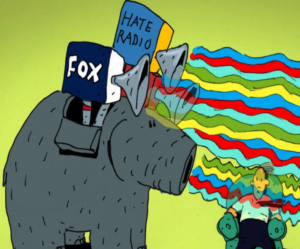 First, the increasingly entangled relationship between Republican elites, media moguls, and radical right-wing populism. This led to the growth of a conservative media ecology, which includes such institutions as Fox News (est. 1996), Newsmax (est. 1998), InfoWars (est. 1999), and Breitbart (est. 2007). Misinformation is both generated within and circulated by these outlets to advance the policy aims of big business as well as fight the influence of democratic institutions and limit civil liberties for marginalized communities.
First, the increasingly entangled relationship between Republican elites, media moguls, and radical right-wing populism. This led to the growth of a conservative media ecology, which includes such institutions as Fox News (est. 1996), Newsmax (est. 1998), InfoWars (est. 1999), and Breitbart (est. 2007). Misinformation is both generated within and circulated by these outlets to advance the policy aims of big business as well as fight the influence of democratic institutions and limit civil liberties for marginalized communities.
Over the last 30 years, four factors have led
to the intensification and expansion of misinformation
 Second, the deregulation of the media industries. Major policies such as the Telecommunications Act of 1996 and cycles of a laissez-faire FCC during both republican and democratic administrations have led to a loosening of restrictions and less accountability for how media organizations operate.
Second, the deregulation of the media industries. Major policies such as the Telecommunications Act of 1996 and cycles of a laissez-faire FCC during both republican and democratic administrations have led to a loosening of restrictions and less accountability for how media organizations operate.
 Third, the development of social media platforms (Facebook, YouTube, Twitter) has made information sharing faster and more accessible. The lack of oversight, combined with their algorithms privileging attention-grabbing content, has facilitated the ease with which misinformation spreads online.
Third, the development of social media platforms (Facebook, YouTube, Twitter) has made information sharing faster and more accessible. The lack of oversight, combined with their algorithms privileging attention-grabbing content, has facilitated the ease with which misinformation spreads online.
 Fourth, a weakened sphere of credible journalism. Many newspapers have struggled to find a profitable model for the digital age, suffered a major loss of advertising revenue, and experienced a decline in public funding. This has resulted in severely understaffed newsrooms (print newspapers have cut half their personnel since 2000) and “news deserts,” which are areas without access to reliable local news.
Fourth, a weakened sphere of credible journalism. Many newspapers have struggled to find a profitable model for the digital age, suffered a major loss of advertising revenue, and experienced a decline in public funding. This has resulted in severely understaffed newsrooms (print newspapers have cut half their personnel since 2000) and “news deserts,” which are areas without access to reliable local news.
References W. Lance Bennett and Steven Livingston, eds. The Disinformation Age: Politics, Technology, and Disruptive Communication in the United States (Cambridge: Cambridge University Press, 2021); Victor Pickard, Democracy Without Journalism? Confronting the Misinformation Society (Oxford: Oxford University Press, 2020). Image credits: First, Bill Plympton, from the documentary The Brainwashing of My Dad (Jen Senko, 2015). Second, Iaroslav Neliubov, “Scissors Cut Red Ribbon Closeup,” Shutterstock. Third, BigTunaOnline, iPhone X with icons of social media, Shutterstock. Fourth, Shiva Bhusal, “A Man With a Clock on His Hand is Holding a Lit Fire Newspaper,” Shutterstock. Background theme image from Shutterstock.
